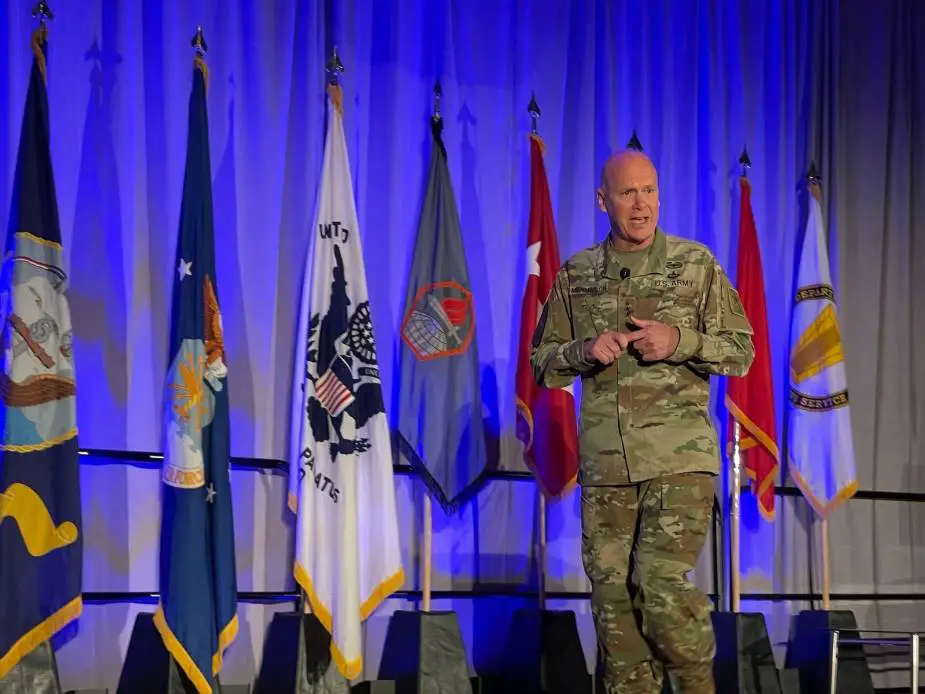US Army to outline operational impact of Army Unified Network during AUSA 2021
On October 8, 2021, the U.S. Army released the Army Unified Network Plan, which is the critical enabler to establishing the Army’s Multi-Domain Operations capable force by 2028. The Unified Network enables Army formations, as part of the Joint Force, to operate in highly contested and congested operational environments with the speed and global range to achieve decision dominance and maintain overmatch. The plan shapes, synchronizes, integrates and governs Unified Network efforts and aligns the personnel, organizational structure and capabilities required to enable MDO at all echelons. The Office of the Army Deputy Chief of Staff, G-6, explains.
Follow Army Recognition on Google News at this link

Lt. Gen. John Morrison Jr., Deputy Chief of Staff, G-6, discussed the Army’s Unified Network Plan during his keynote address at the Armed Forces Communications and Electronics Association’s 2021 TechNet conference in Augusta, Ga., 18 August 2021 (Picture source: U.S. Army/G-6 Staff)
While the U.S. Army has made tremendous strides toward modernizing its tactical formations with the deployment of Integrated Tactical Network capability sets, enterprise modernization efforts at the strategic and operational levels have significantly lagged and focused primarily on unclassified local area networks on Army installations. This unbalanced approach creates unintended seams that the network modernization approach is now addressing through the Army Unified Network Plan.
The Unified Network will integrate the Army’s various network efforts to allow secure and seamless communications using our mission networks, our support to Joint All Domain Command and Control with sister services, and the mission partner environment with our partners and allies.
“Our potential adversaries’ threats continue to increase in number, degree of complexity and level of physical and technical damage they can inflict,” said Lt. Gen. John Morrison Jr., Deputy Chief of Staff of G-6. Morrison will join other military leaders to discuss the Unified Network during this year’s Association of the United States Army Annual Meeting, held Oct. 11-13 in Washington, D.C., and broadcast virtually worldwide.
The meeting will kick off with a Defense News panel discussion on Oct. 11, featuring Lt. Gen. John Morrison Jr., Deputy Chief of Staff of G-6; Brig. Gen. Jeth Rey, director of the Network Cross-Functional Team; Mr. Ross Guckert, Program Executive Officer EIS; and Maj. Gen. Robert Collins, Program Executive Officer for Command, Control and Communications-Tactical. During the presentation, panel members will discuss the Unified Network plan and how their organizations are supporting it.
The discussion will continue with an emphasis on the operational perspective on Oct. 12 during the Warriors Corner, with presentations from Maj. Gen. Christopher Donahue, commanding general of the 82nd Airborne Division; Maj. Gen. Thomas Pugh, G-6 Director of Networks, Services and Strategy; Maj. Gen. Robert Collins, Program Executive Officer for Command, Control, and Communications-Tactical; and Brig. Gen. Jeth Rey, director of the Network Cross-Functional Team.
During the Warriors Corner, the leaders will share their perspectives on the operational need for a Unified Network and how it will enable the secure and rapid transfer of data to, from and across the battlefield – even in the most challenging electromagnetic spectrum and cyber environments. “We have to look at it from the tactical edge back to the strategic environment,” Rey said. “The Army has to close that gap in order to empower commanders now and enable Multi-Domain Operations in the future. A critical step to achieving a Unified Network will be driving the Army’s communications technology to be data-centric, transport-agnostic and underpinned by a multi-layered security architecture”, Rey said. “In simple terms, this means that Soldiers will be able to securely access and operate on the network with the information they need – just like you can log in to a digital bank database that has millions of other users, but the bank only renders your financial information to you,” he added.
The Unified Network is not just a thing, and is more than developing and fielding capabilities – it is a holistic approach that addresses our people, training, organizations, policies and processes.
“The only way we can bring the power of the nation, across all warfighting domains, at the time and place of the commander’s choosing to deliver strategic effects to the tactical edge – whether in competition or conflict – is with the Unified Network,” Morrison said. “To conduct MDO and be an MDO capable force by 2028, we must have a Unified Network. It’s not just a requirement, it’s an operational imperative.”


























